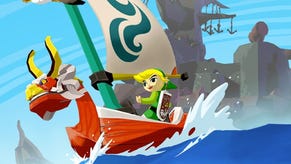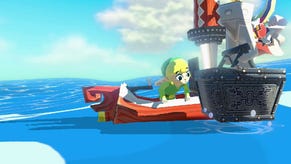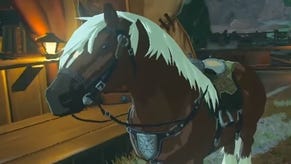The Legend of Zelda: The Wind Waker review
Hands-On - Nintendo invites Mugwum over to play Zelda, and he promptly dies of excitement

Celda
The biggest talking point amongst Zelda fans since SpaceWorld 2001 has been the issue of cel-shading. So, before I get started, I would like to rub the slate clean here and declare that Zelda isn't cel-shaded in the traditional sense. It's an interactive cartoon. For a start, one fairly regular feature of cel-shaded games is a thick, black line surrounding just about everything, and I didn't spot any such black lines. Secondly, the character design and environments are very much like those from Zelda III, except in three dimensions, and viewed from above and behind.
Link is back to his childish self, with big eyes and pupils, floppy hair and childish behaviour, like hopping up and down in the manner of an excited school kid after defeating a boss character. NPCs are also well designed; in particular the old timer who teaches Link how to fight. As Link lands horizontal, vertical and downward thrusting blows the old bloke measures and blocks them clearly and precisely. Everything seems incredibly solid, and collision detection is of the utmost importance in sustaining a cartoon world, as any designer will tell you.
Starting my session with the game knee-deep in blades of grass and slashing through them, I could imagine viewing the thing from above on my SNES all those years ago. Grass sways back and forth here though, water splashes and froths, dust is kicked up and haze rises from fiery craters. The transition to GameCube coupled with the decision to use this cartoon approach has given Shigeru Miyamoto's team the opportunity to play to the hardware instead of fighting for framerate. As such, boss characters are enormous, huge rolling vistas stretch for as far as the eye can see and ships bob frantically in the deep blue of the ocean, with details on islands and in the water visible from hundreds of metres away.
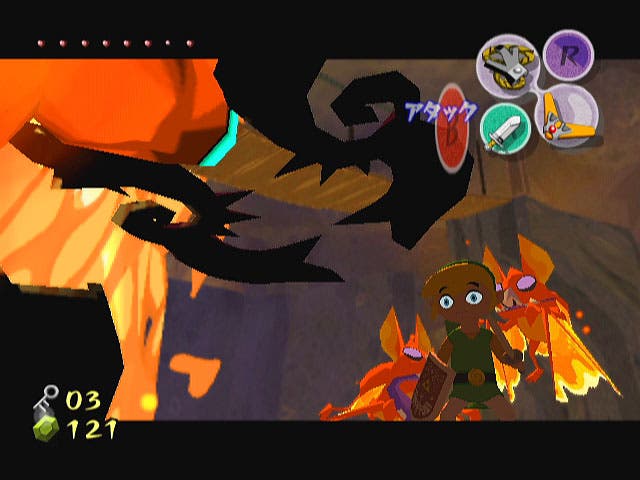
Legendary
The presentation and animation means that far from just looking like a cartoon in still shots, The Legend of Zelda is very much a Saturday morning cartoon in feel. The scene in our demo, with Link arriving at a mysterious island in a pirate ship, is a good example. His two accomplices encourage him to step into a barrel and be hurled from a cannon into the complex to avoid detection, and you get to see a nervous Link flinch as the fuse is lit, grit his teeth as the countdown begins, gawp as he leaves his friends miles behind him, and then frown wearily as the barrel hits a tower and he falls into the dock.
Other touches which add to the game's cartoon credentials include a clever three-tone darkness and shadow effect, leaving Link's tunic bright in the foreground, shady in the middle and dark away from camera. Of course, shadows can be cast across him too, which is doubtless to be used to dramatic effect in typical Miyamoto fashion later on. And as the GameCube is a fairly powerful little box, it's given Miyamoto and his team the chance to play with new effects. The aforementioned heat haze is wonderful, most noticeable in the demo's boss fight, but there are also explosions, with streams of light issuing forth like spotlights and big circular waves of fire expanding from the centre, and all manner of other buzzwordable concoctions born of somebody's creative imagination.
However, at this stage I really want to tell you about the boss fight. Zelda fans are used to big bosses, but this chap is easily more than a hundred times your size, occupying a lake of fire in a cavern. Curiously, a dragon's tail can be seen above him, belonging unsurprisingly to the dragon sunning itself atop the mountain - and who can blame him on such a hot day? The chap below seems to like the heat though. In fact, he's almost entirely composed of fire by the looks of things. His exoskeleton makes attack pointless, but you can see his hot, throbbing lava innards in a couple of places, and sure enough, by ticking off the dragon above (swinging from his tail does the trick), you can cause huge slabs of rock to drop down and gradually flakes of exoskeleton will disappear, until he's almost completely exposed. At this point he gets angry, slapping down his pincers and breathing fire at you, leaving just enough time for you to roll hastily beneath his arm and escape. It's such a wonderful encounter, but it's over in less than five minutes once you get the hang of it, suggesting to us at least that this isn't even a major boss. And that bodes very well indeed.
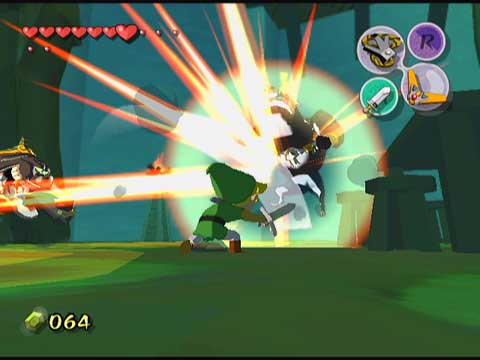
Back to the Future
Naturally The Legend of Zelda has to be far more than just a pretty picture. The story behind the game is quite sensibly shrouded in mystery at this stage, but we do know that Link is on a mission to rescue his sister Arilla, who was plucked from him by a bird as the game begins. Some sections of the press have even suggested that Arilla could be the friend alluded to in the tale of Majora's Mask, Link's second N64 adventure, but despite ties to Majora, his first outing on the GameCube is very much in the style of Ocarina of Time.
The most obvious parallels lie in the combat system. Link can still make horizontal and vertical slashes and perform his signature downward thrust, and automatic jumping and so on are back as well, but on top of that Link can now sidle up against walls, peep round corners like a wannabe Solid Snake, and much more. In the full game, we're promised a number of sword techniques to be learnt throughout (and even some spells), but most of this is absent at this stage. However, Miyamoto was good enough to give us a go with Link's charging attack, particularly useful in his role as an eco-warrior, which, despite what you might think, means that he wants to hack down trees, bushes, grass and just about everything else from the plant kingdom.
Once Link's sword glows bright orange he can unleash a devastating tornado-style attack, sword outstretched, completely under your control, and take out anything in his path and about a metre on any side of him. This being Zelda though, it isn't long before you spot the balance, and in this case, once halted, this spinning-top-of-pure-destruction is so puffed out he has to stop and catch his breath, leaving him exposed to retaliation. Although not from plants, obviously.

A Link to the Past
The control system is typically intuitive and intelligently designed. The Z-lock is replaced by essentially similar L-targeting, while the R trigger handles your shield and the A button is used for swiping people with your sword. The B button's functionality changes depending on the situation though; in battle, Link can often jump out of the way of attacks or roll beneath sharpened pincers, whereas in other situations (for instance, if you fancy pushing a block around) you can sheath your sword with it, or talk to an NPC, or something along those lines. The Y button also has a set task - the hookshot. Your eyes just lit up, I can tell. Yes, the hookshot is back, and of course you can swing across lava pits and latch onto anything, as long as it has what can only be described as a "POW!" box over it. You tap Y once to target, then once again to fire. Simplicity itself.
In another nice touch, you can also now pick up weapons dropped by your recently deceased enemies. Having spent some time playing Drakan lately, that one really cheered me up. Cleverly, weapons dropped are only limited-use, so when you knock down a nasty fellow with a big club, you have just enough blows at your disposal to carve your way through a heavy-set wooden door - something you otherwise wouldn't be able to accomplish.
Rounding off our experience with The Legend of Zelda, it seems worth mentioning Epona's spiritual successor: Link's boat. This cute little sailing boat shows up in a mini-game, where you have to race around the beautifully realised ocean collecting as many Rupees as possible. Typical Zelda, typically enjoyable, and typical in its execution of the quality of the experience, even at this early stage.
Conclusion
It seems clear that Shigeru Miyamoto has stayed true to the principles of the Zelda series instead of attempting to revolutionise it with throwaway gimmicks. Some people will still complain about the cartoon approach, but to be blunt, once you've seen it in motion you would have to want to not like it to find it disagreeable. Furthermore, although some people will complain that the story (Link living happily, life disrupted by the abduction of his sister, etc) is rather shallow, clichéd and unbecoming of the series, this is a work in progress, and you just have to look at all these journalists backtracking on their outraged editorials about cel-shading to see why I've got every faith in Nintendo to produce something worthy of the Zelda name. Based on my experience with Legend Of Zelda, we won't be disappointed.


